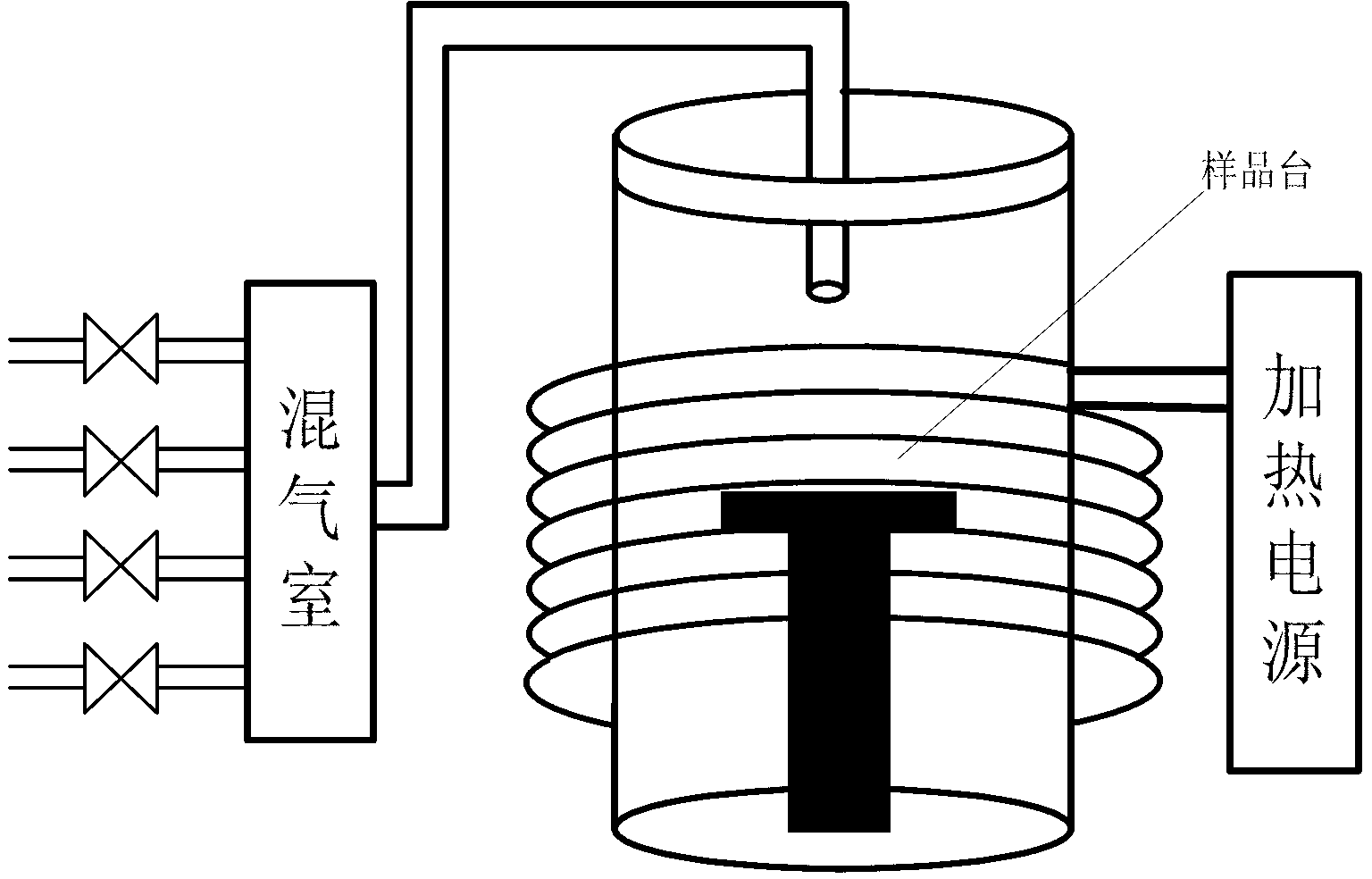Method for preparing graphene on SiC substrate based on Ni film annealing and chlorine reaction
A graphene and substrate technology, applied in the field of microelectronics, can solve problems such as low processing temperature, graphene film defects, and inappropriate production, and achieve the effects of low porosity, fast reaction rate, and uniform and controllable thickness
- Summary
- Abstract
- Description
- Claims
- Application Information
AI Technical Summary
Problems solved by technology
Method used
Image
Examples
Embodiment 1
[0036] Embodiment 1, making 4H-SiC and Cl 2 Reaction and Ni film annealing of large-area graphene.
[0037] Step 1: The 4H-SiC substrate is cleaned by the RCA method to remove organic and inorganic chemical pollutants on the sample surface:
[0038] (1a) Place the 4H-SiC substrate in deionized water for ultrasonic cleaning for 15 minutes, take it out, and rinse it repeatedly with deionized water;
[0039] (1b) Soak the cleaned 4H-SiC substrate in a solution of ammonia water: hydrogen peroxide: deionized water = 1:2:5, boil it, soak for 15 minutes, and repeatedly clean it for the second time with deionized water;
[0040] (1c) The 4H-SiC substrate after the second cleaning was immersed in a solution of hydrochloric acid: hydrogen peroxide: deionized water = 1:2:8, boiled, soaked for 15 minutes, and washed repeatedly with deionized water for the third time.
[0041] Step 2: performing hydrogen etching on the 4H-SiC substrate after RCA cleaning.
[0042] Set the pressure in th...
Embodiment 2
[0056] Embodiment 2, making 6H-SiC and Cl 2 Reaction and Ni film annealing of large-area graphene.
[0057] Step 1: Clean the 6H-SiC substrate by RCA method to remove organic and inorganic chemical pollutants on the sample surface:
[0058] (1.1) Place the 6H-SiC substrate in deionized water for ultrasonic cleaning for 15 minutes, take it out, and rinse it repeatedly with deionized water;
[0059] (1.2) Soak the cleaned 6H-SiC substrate in a solution of ammonia water: hydrogen peroxide: deionized water = 1:2:5, boil it, soak for 15 minutes, and wash it repeatedly with deionized water for the second time;
[0060] (1.3) The 6H-SiC substrate after the second cleaning was immersed in a solution of hydrochloric acid: hydrogen peroxide: deionized water = 1:2:8, boiled, soaked for 15 minutes, and washed repeatedly with deionized water for the third time.
[0061] Step 2: performing hydrogen etching on the 6H-SiC substrate cleaned by RCA.
[0062] Set the pressure in the reaction ...
Embodiment 3
[0075] Embodiment 3, making 6H-SiC and Cl 2 Reaction and Ni film annealing of large-area graphene.
[0076] Step A: Clean the 6H-SiC substrate by RCA method to remove organic and inorganic chemical pollutants on the sample surface:
[0077] The cleaning process is the same as step 1 in Example 1.
[0078] Step B: Set the pressure in the reaction chamber to 13.3Pa, raise the temperature to 1600°C, and perform hydrogen etching on the substrate for 20 minutes with a hydrogen flow rate of 120L / min to remove scratches on the surface of the 6H-SiC substrate and produce nanoscale high The periodic smooth step morphology.
[0079] Step C: After completing the hydrogen etching, lower the temperature to 1000°C, and pass in hydrogen with a flow rate of 4L / min for 15 minutes; cool down to 850°C, and pass in SiH with a flow rate of 0.5ml / min 4 , keep for 10 minutes; stop ventilation, raise the temperature to 1000°C, keep for 10 minutes; raise the temperature to 1100°C, keep for 10 minut...
PUM
 Login to View More
Login to View More Abstract
Description
Claims
Application Information
 Login to View More
Login to View More - Generate Ideas
- Intellectual Property
- Life Sciences
- Materials
- Tech Scout
- Unparalleled Data Quality
- Higher Quality Content
- 60% Fewer Hallucinations
Browse by: Latest US Patents, China's latest patents, Technical Efficacy Thesaurus, Application Domain, Technology Topic, Popular Technical Reports.
© 2025 PatSnap. All rights reserved.Legal|Privacy policy|Modern Slavery Act Transparency Statement|Sitemap|About US| Contact US: help@patsnap.com


